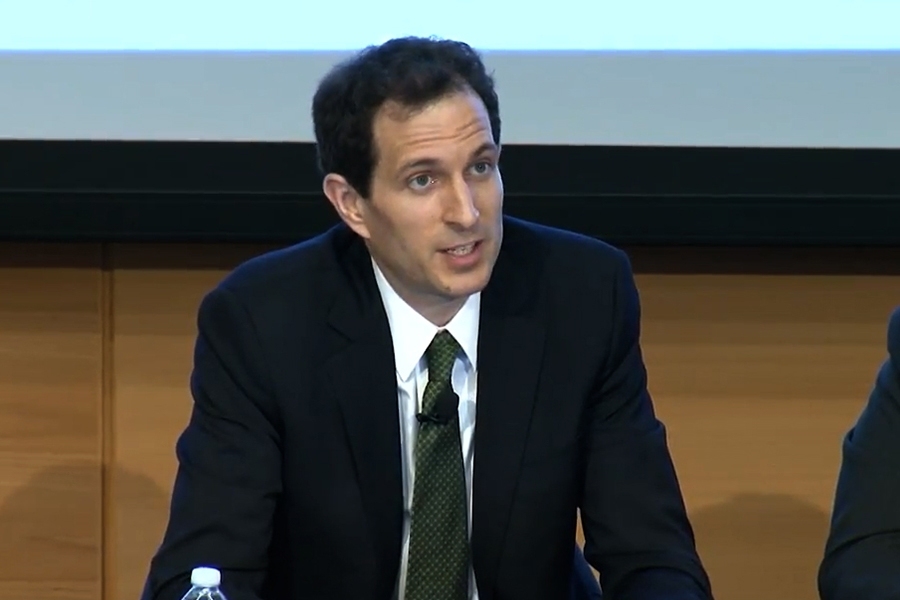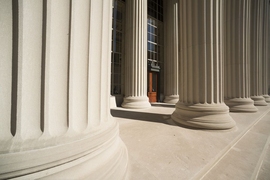On June 26, the U.S. Supreme Court agreed to hear arguments relating to President Donald Trump's recent executive order on travel, which limits individuals from six majority-Musliim countries and refugees worldwide from entering the United States. The court also ruled to uphold a limited version of the travel ban, which went into effect on June 29. President Trump cited this as “a clear victory for our national security.”
Justin Steil, assistant professor of professor of law and urban planning at MIT, firmly disagrees. Steil is a member of the The Inter-University Committee on International Migration — a focal point for migration and refugee studies at six universities in the greater Boston area that's hosted by the MIT Center for International of Studies (CIS). He recently spoke with the CIS, arguing that such policies undermine our nation’s security and that immigration makes the U.S. more safe, not less.
Q: What concerns you most about the Supreme Court decision to allow parts of the travel ban to go into effect?
A: The revised executive order seeking to temporarily ban the migration to the United States of refugees worldwide and of individuals from six predominantly Muslim countries presents both foreign-born residents, particularly Muslim residents, of the United States and those seeking to immigrate here as a threat to national security, against the evidence. The Supreme Court’s decision to stay, in part, the preliminary injunctions issued by the Fourth and Ninth Circuit Courts of Appeal and preventing implementation of that executive order unfortunately lends credence to the administration’s political theater. The court’s decision continues to allow the entry of refugees or migrants from the six countries who have “a credible claim of a bona fide relationship with a person or entity in the United States” but stays the injunction as to other affected foreign nationals.
What concerns me most about the court’s decision to let part of Executive Order 13780 go into effect is the impact it will have on refugees who are fleeing persecution in their countries of origin and on immigrants hoping to build a new life and contribute to the vibrancy and growth of the United States.
I am also concerned about the message the executive order, and the court’s validation of it, sends to the rest of the world, to the potential immigrants who have always contributed and who continue to contribute to the United States, economically, intellectually, culturally, artistically, and in other ways. Thousands of communities across the United States are eager to welcome immigrants, but the order sends a message of fear and division both at home and abroad, and makes it that much more difficult for immigrants to enrich the fabric of our local social and economic lives. In my research analyzing local government policymaking with regard to immigrants, I have seen immigrants scapegoated for political gain, and I have also seen that the targeting of immigrants often comes back to have negative social, economic, and political consequences for the rest of those in the locality, including increasing political polarization and fragmentation in social life, and even violence.
Q: The Trump administration consistently portrays immigrants as a primary threat to national security. Does this stand up to a fact check?
A: Despite the fact that the vast majority of U.S. citizens are descended from either voluntary or involuntary migrants, and the United States often represents itself as a nation of immigrants, it is also a place where, for centuries, some have represented the foreign-born as a danger to the nation’s values and its security.
As described in an amicus brief by a bipartisan group of former national security officials, there is no legitimate national security rationale for the executive order, and it will instead disrupt existing counterterrorism partnerships, endanger U.S. troops in the field, and have a negative impact on U.S. citizens at home. Refugees — those individuals who have fled their country of nationality because of persecution on account of race, religion, nationality, membership in a particular social group, or political opinion — are already some of the most carefully vetted migrants to the United States and, since the passage of the Refugee Act of 1980, have not been associated with even a single terrorist attack in the United States. Nor has a single citizen of the six countries targeted by the Executive Order killed anyone in a terrorist attack in the United States in at least the last four decades, if ever. In the past 15 years, more terrorist attacks have been committed, and significantly more Americans have been killed, by native-born attackers than by foreign-born ones.
Beyond the executive order at issue here, the current White House has worked hard to paint a picture of immigrants generally as a threat to public safety, whether from crime or from terrorism. But overwhelming social scientific evidence has consistently found that immigrants (both documented and undocumented) are significantly less likely to commit crimes than native-born Americans. And higher shares of immigrants have aggregate benefits as well: Cities with larger shares of immigrants have lower crime rates than those with fewer immigrants, and the cities that experienced the largest increase in their foreign-born populations between 1990 and 2000 experienced the largest decrease in murder rates over the same period.
My own research at the municipal level has found that anti-immigrant policies are actually more likely to be enacted in cities where violent crime is decreasing than ones where it is increasing, but that immigrants in those cities are nevertheless blamed for crime and that anti-immigrant rhetoric is used for political gain.
In short, immigration generally makes the United States more, not less, safe. Certainly careful review of those seeking to enter the United States is necessary, but neither bans on refugee admissions, nor bans on migration from certain countries, nor mass deportations will make America safer.
Q: What’s your predicted outcome for the Supreme Court decision this fall?
A: It is hard to say what the court will do. The Supreme Court has historically been hesitant to intervene in the Executive Branch’s power over immigration, especially when national security justifications are invoked. But reference to national security cannot exempt an executive policy from judicial review.
The court asked for additional briefing on whether the case will be moot by the time it is argued in October, so the court may dismiss it as moot. If the court does reach the merits of the case, the most discussed legal argument against the executive order is that it violates the First Amendment’s prohibition on favoring one religion over another. A second argument is that parts of the order violate provisions of the Immigration and Nationality Act (INA), including the provision prohibiting discrimination in the issuance of an immigrant visa on the basis of a person’s race, sex, nationality, place of birth, or place of residence. There are numerous additional arguments, but I’ll just discuss those two.
The Establishment Clause of the First Amendment states that the government “shall make no law respecting an establishment of religion.” This clause prohibits the government both from establishing an official religion and from favoring one religion over another. The Establishment Clause claim is essentially a challenge based on the president’s intent when he enacted the executive order, and the court is very reluctant to strike down policies based on claims about the discriminatory intent of a policy’s enactor. Indeed, it is often hard to know the intent behind any policy outside of what is written in the policy itself. Some justices may evaluate the executive order based on the text of the revised order alone and, without an explicitly discriminatory classification in that text, argue to uphold it.
Unlike in many cases where discerning intent may be challenging, however, Donald Trump has argued explicitly for a ban on immigration on the basis of religion. For instance, as a candidate, he released a statement on his campaign website calling for “a total and complete shutdown of Muslims entering the United States.” And just before signing the first version of the executive order he said, “This is the ‘Protection of the Nation from Foreign Terrorist Entry into the United States.’ We all know what that means.” Further, the first executive order treated refugees differently on the basis of religion, by excluding from the ban refugees from religious minorities, which Trump explained in an interview to the Christian Broadcasting News would give preference to Christian refugees. Although the executive order does not prohibit all immigration by Muslim individuals to the United States, there is convincing evidence that it did not have a bona fide secular purpose of protecting national security and that its primary purpose instead was to enact a policy discriminating on the basis of religion, in violation of the First Amendment.
The INA prohibits discrimination on the basis of race, sex, nationality, place of birth, or place of residence in the issuance of an immigrant visa — such as legal permanent resident visas — but does not apply to non-immigrant visas — such as tourist visas — and its application to the actual entry of any visa holder into the United States is unclear. What is clear is that this provision was enacted as part of the Immigration and Nationality Act of 1965, influenced by the civil rights movement’s push to challenge the overt discrimination codified in the nation’s immigration system forty years prior. In 1924, Congress had enacted immigration quotas explicitly designed to return the United States to the racial and cultural composition it had in 1890, by excluding immigrants from Southern Europe, Eastern Europe, Asia, and the Middle East. The current administration’s policies have disturbing parallels to these historic white supremacist policies. Regardless of the Supreme Court’s ultimate conclusion about the legality of the current executive order, its mean-spiritedness, short-sightedness, and damage it has done, and will continue to do, are already evident.










